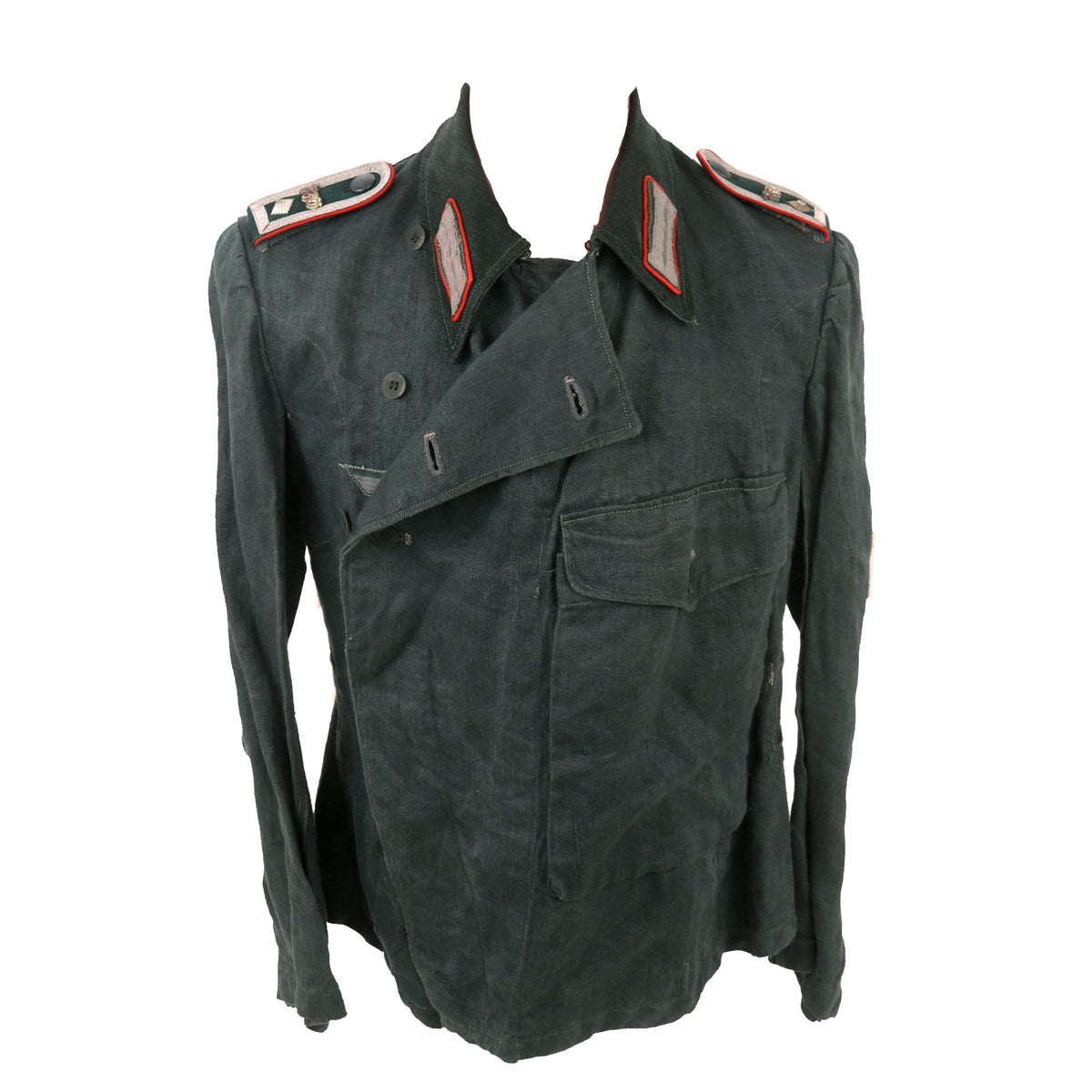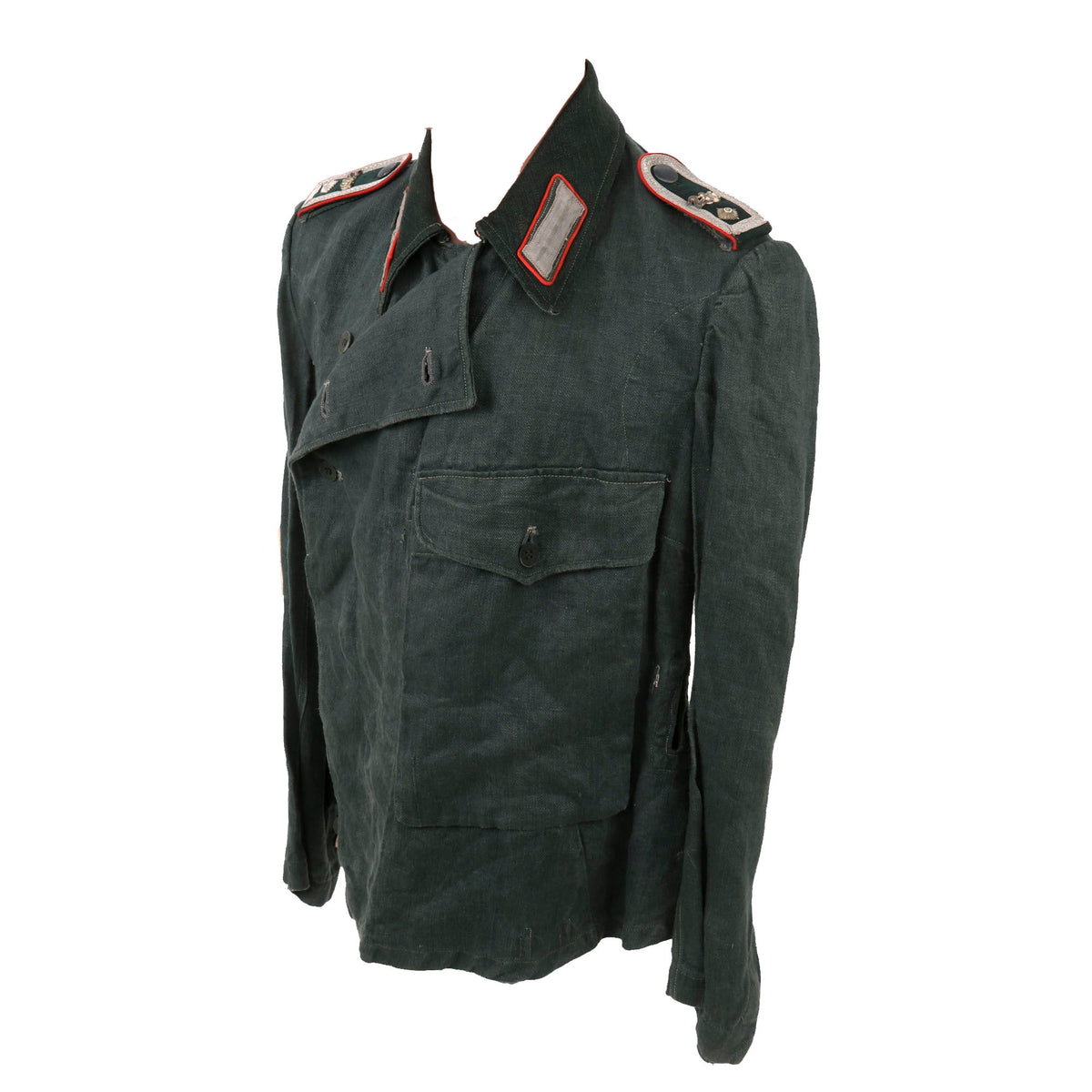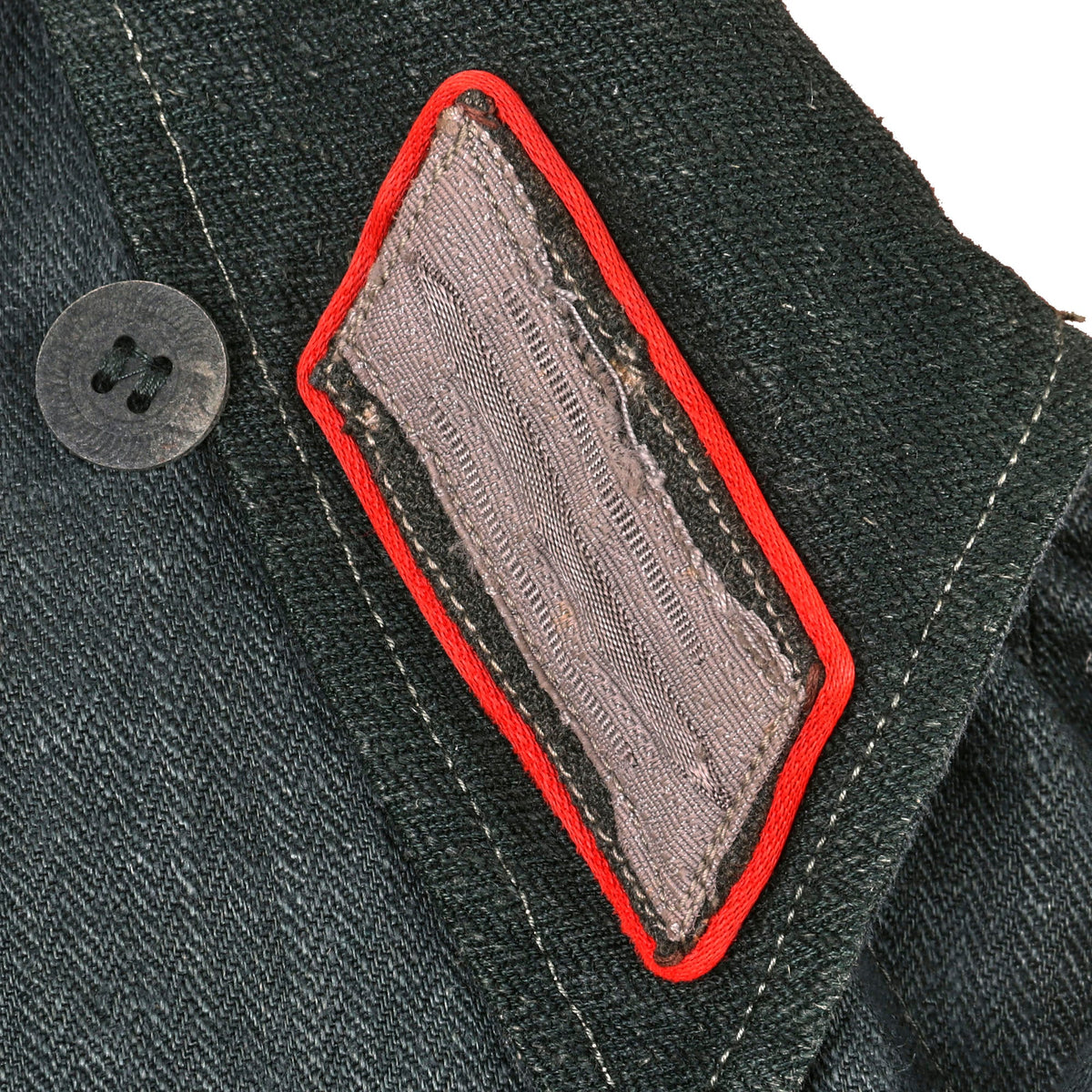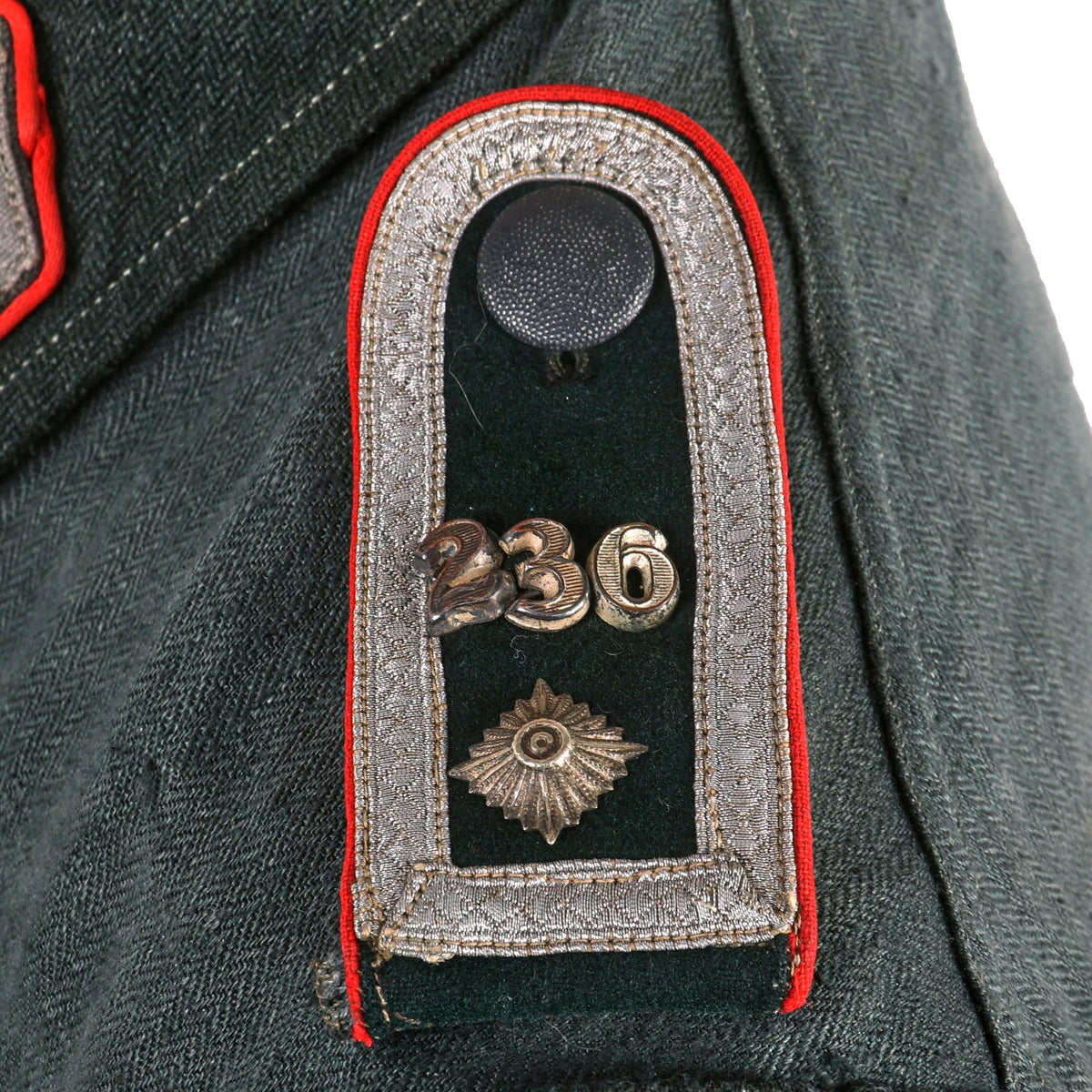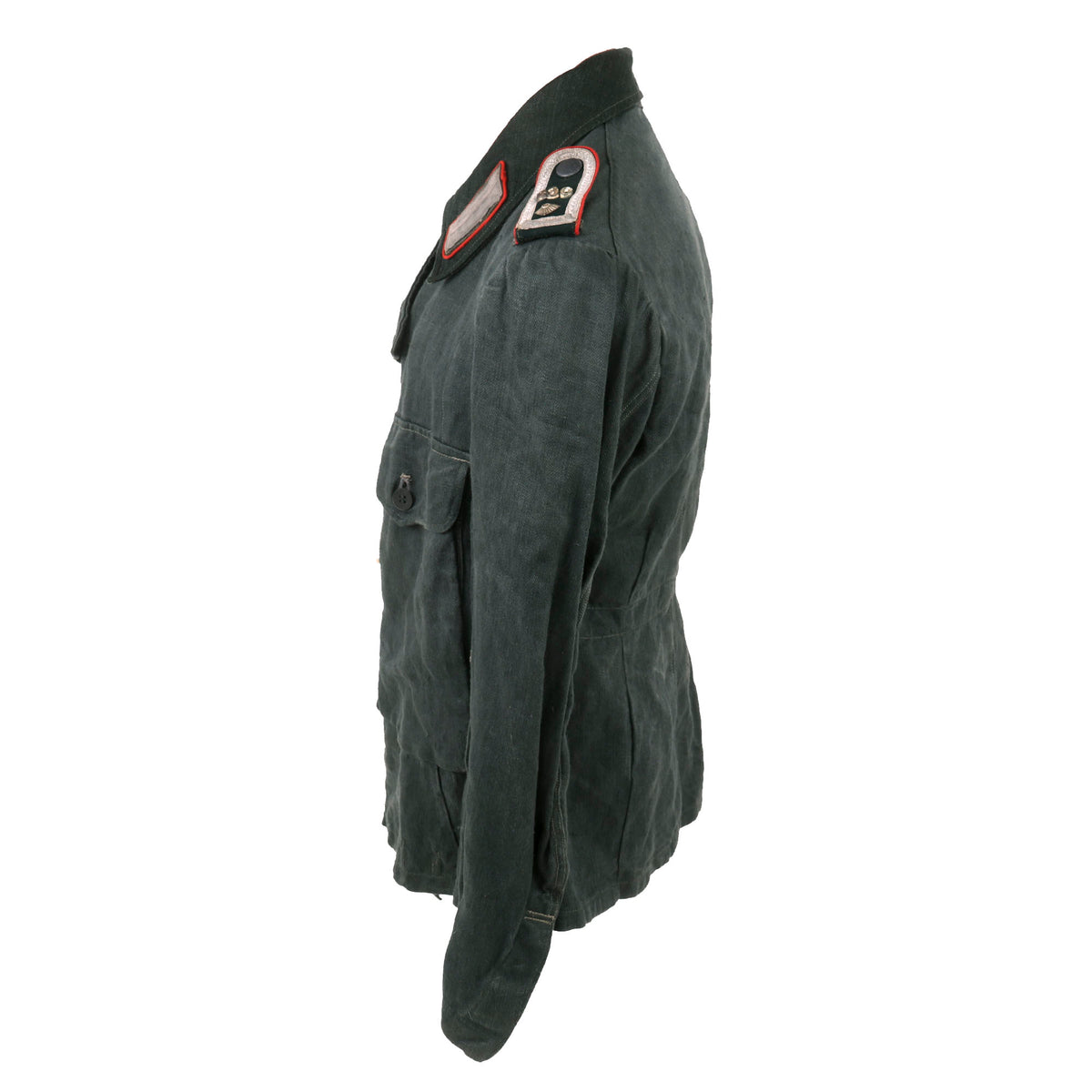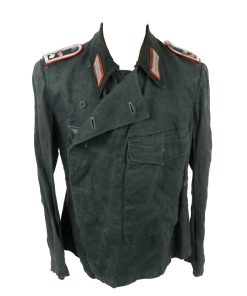Original German WWII Heer 236th Sturmartillerie Feldwebel NCO’s Sturmgeschütz HBT Wrap Uniform Tunic – StuG Wrapper Original Items
$ 3.895,00 $ 973,75
Original Item: Only One Available. This is a great example of a highly desirable and iconic Heer Sturmartillerie (Assault Artillery) NCO “Panzer Wrap” tunic, in the “Field Combat” HBT fabric construction. After 1942 there was an official summer issue HBT Feldbluse uniform designed for field and combat use for the army, a descendant of the “Drillich” fabric drill uniforms during the pre-war period. They manufactured M40, M42, and later M44 patterns in this fabric, as well as the StuG Wrap Tunic, this this is a great example of.
These particular “StuG wrapper” uniforms were worn by troops who manned and operated the self-propelled Sturmgeschütze (assault gun or StuG) anti-tank / infantry support guns. The design of the panzer wrap over tunic was deemed as suitable for StuG crews but as they could be outside of the vehicle more or exposed than Panzer crews it was decided that the field grey color would be better suited. As the field grey color uniform was also the same color as the infantry uniform they blended in better when mixed in with the infantry. They also began to use the summer HBT uniforms when they were issued to the rest of the army.
The Sturmartillerie were officially part of the Artillerie branch and therefore wore wrappers with red Waffenfarbe. When assault guns were being developed, there was a struggle between the Panzer and Artillerie branches for control of this new weapon concept and Artillerie won. They were an integral part of the German “Blitzkrieg” strategy, which allowed them to overrun much of Europe in a relatively short amount of time. The sleek design of the wrap tunic combined with the colorful piping make them look great in just about any setting.
This example is made from the correct summer issue Heer green HBT fabric, and is really a great example of this type of StuG Wrapper. This example actually has 14 plastic buttons on the front closure, including two on the far edge that secure to loops on the inside of the jacket. Then there is a row of 7 going vertically, and and inch and a half farther away, there is a row of 5 going vertically. So it looks like this wrapper was meant to close in two different sizes, possibly depending on the weather, or how much clothing was worn underneath. To preserve the streamlined look, the bottom 4 of these buttons are “hidden”, with only the top three exposed. There is also a “hook and loop” fastener for the collar, so the wrapper could be secured easily with the neck open, or closed. The buttons on the tunic are sewn directly to the fabric. Definitely an interesting design on this wrapper!
There is no real lining on the inside of the wrapper, just some reinforcement in areas. The only pocket on the tunic is the large one on the left front side. The inside of the right flap does show some faded size and maker markings, however we are not able to read them due to how dark the fabric is.
The tunic is adorned with the usual rank and branch insignia used on German tunics. The attractive Army breast eagle is the correct EM/NCO BeVO embroidered type, a 1940 pattern with gray thread on a green background. It is very neatly hand stitched to the chest in a fashion typical of wartime German tailor work. There are EM/NCO litzen collar patches on each side, which are woven from white thread with a dark green background matching the collar. They do not have Corps Color stripes, as in 1938 they were removed from EM/NCO collar insignia to save time. However, around the outside they are piped with Hochrot (Deep Red) fabric, the Waffenfarbe (Corps Color) during WWII for Artillery, Assault guns (Sturmgeschütze), and Heavy Flak soldiers. It is also the color used for General Level Officers, however as this is an NCO tunic, this is definitely for artillery.
The button attached style NCO shoulder straps (Unteroffiziere Schulterklappen) attached to the tunic have a dark “bottle green” base wool, with a silver diamond-woven tresse border all the way around. ONE rank pip is present on the shoulder boards, indicating the rank of Feldwebel, an NCO rank equivalent to a U.S. Army Technical Sgt. They have the correct red piping for artillery, and have metal unit numbers on both sides displaying 236. We did some preliminary research, and this most likely corresponds to Sturmgeschütz-Abteilung 236, which was later renamed Sturmgeschütz-Brigade 236 during February 1944, and then Heeres-Sturmartillerie-Brigade 236 in June 1944. It was placed under command of the 4. Panzerarmee towards the end of the war.
Overall condition is very good, with light wear and staining consistent with service. There is some wear to the insignia, as well as some overall wear, but nothing major. The colors are very well retained on this StuG Wrapper, and it really has a fantastic look.
This is a great chance to pick up a lovely example of a very rare and desirable StuG Wrapper, only the second that we have ever had, and the only one made from HBT fabric! In many ways these are harder to find than the Iconic Black Panzer Wrapper version. Ready to research and display!
Approximate Measurements:
Collar to shoulder: 9.5″
Shoulder to sleeve: 25”
Shoulder to shoulder: 16.5”
Chest width: 17″
Waist width: 17″
Hip width: 19″
Front length: 29″
Fast Shipping with Professional Packaging
Thanks to our longstanding association with UPS FedEx DHL, and other major international carriers, we are able to provide a range of shipping options. Our warehouse staff is expertly trained and will wrap your products according to our exact and precise specifications. Prior to shipping, your goods will be thoroughly examined and securely secured. We ship to thousands clients each day across multiple countries. This shows how we're dedicated to be the largest retailer on the internet. Warehouses and distribution centres can be located throughout Europe as well as the USA.
Note: Orders with more than one item will be assigned a processing date depending on the item.
Before shipping before shipping, we'll conduct a thorough inspection of the items you have ordered. Today, the majority of orders will be delivered within 48 hours. The delivery time will be between 3-7 days.
Returns
The stock is dynamic and we cannot completely manage it because multiple stakeholders are involved, including our factory and warehouse. So the actual stock may alter at any time. It's possible that you may not receive your order once the order has been made.
Our policy is valid for a period of 30 days. If you don't receive the product within 30 days, we are not able to issue a refund or an exchange.
You can only return an item if it is unused and in the same state as the day you received it. You must have the item in its original packaging.
Related products
Uncategorized
Uncategorized
Uncategorized
Uncategorized
Uncategorized
Uncategorized
Uncategorized
Uncategorized
Uncategorized
Armoured Fighting Vehicles of the World: AFVs of World War One (Hardcover Book) New Made Items
Uncategorized
Uncategorized
Australian WWII Owen MK1 Machine Carbine SMG Custom Fabricated Replica with Sling Original Items
Uncategorized
Uncategorized
Uncategorized
Armored Burgonet Helmet & Polearm from Scottish Castle Leith Hall Circa 1700 Original Items
Uncategorized
Angolan Rebel 1970s era 60mm Inert Display Mortar from Angolan Civil War Original Items
Uncategorized
Uncategorized
Uncategorized
Uncategorized
